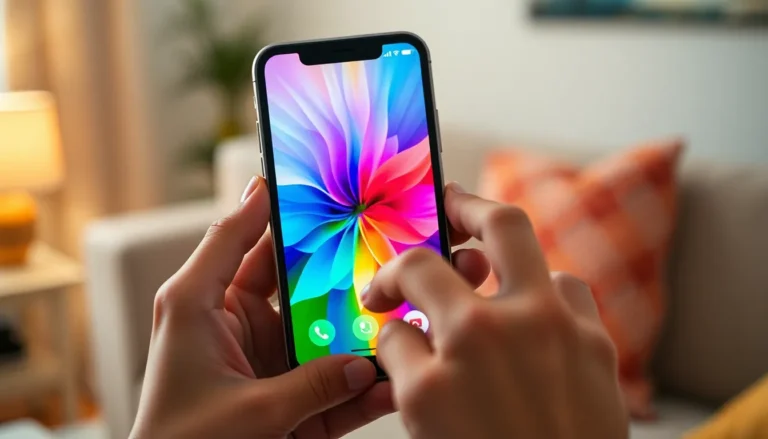Table of Contents
ToggleEver found yourself squinting at your iPhone’s keyboard like it’s a fine print on a legal document? You’re not alone! Many users wish for a larger keyboard to avoid those dreaded typos and accidental emoji explosions. The good news is, there’s hope for those who dream of a more spacious typing experience.
Overview of iPhone Keyboard Size
iPhone users often experience difficulty due to the small keyboard size. This issue frequently results in typos and unintended emoji usage. A larger keyboard could enhance typing comfort and accuracy. Apple designs its keyboard for optimal use across various screen sizes, balancing compactness with functionality. However, certain features exist for those desiring a bigger typing surface.
Changing the keyboard settings provides immediate results. Users can enable “Zoomed Display” in the display settings, which increases overall screen size, including the keyboard. This option allows for larger keys, making typing easier. Additionally, third-party keyboard apps offer alternatives with customizable sizes. Popular apps like Gboard and SwiftKey allow users to adjust key sizes to their preference.
Adjusting the font size might also impact keyboard usability. Increasing the font size in display settings can provide a clearer view of the keys, although it does not increase the actual keyboard size. Users aiming for improved comfort can also explore accessibility settings. Features such as “Larger Text” enhance visibility without altering screen layout.
Utilizing landscape mode when typing provides another solution. Rotating the device to landscape orientation enlarges the keyboard significantly. This mode often allows for more comfortable typing in certain applications. Experimenting with different settings and orientations assists in finding an optimal keyboard size. Through these steps, iPhone users can improve their typing experience significantly.
Reasons for Enlarging the Keyboard

Adjusting the keyboard size can significantly enhance typing experiences for various users. Several factors influence the need for a larger keyboard.
Accessibility Needs
Individuals with visual impairments often find smaller keyboards challenging. Enlarged keys can improve accessibility and provide a more comfortable typing experience. Users with motor skill difficulties benefit from increased key size, reducing typing errors. Accommodating these needs fosters inclusivity for iPhone users who require more accessible technology.
User Preferences
Some users simply prefer a larger keyboard for better visibility. Larger keys permit quicker, more accurate typing and minimize accidental presses. Personalized settings, like adjusting the keyboard size, cater to individual preferences, making texting or typing more enjoyable. Exploring customizable keyboard options further enhances the user experience by aligning with specific style and comfort needs.
Methods to Make the Keyboard Bigger on iPhone
Several methods can increase the keyboard size on iPhone, enhancing the typing experience.
Using Settings Adjustments
Adjusting settings is a straightforward way to make the keyboard bigger. Users can enable “Zoomed Display” under Display Settings, which enlarges the overall screen size, including the keyboard. This option offers a more comfortable typing experience without replacing the default keyboard. Additionally, adjusting text size can improve clarity and make on-screen elements more legible. Navigate to Accessibility, select Display & Text Size, then increase the text size for better visibility. Those with vision challenges benefit significantly from these tweaks, enjoying enhanced usability.
Installing Third-Party Apps
Third-party apps provide another solution for larger keyboards. Users can download apps like Gboard or SwiftKey from the App Store, which allow for customizable keyboard sizes and unique features. Both apps offer adjustable height settings, enabling users to choose sizes that suit their preferences. SwiftKey provides personalized layouts based on typing habits, while Gboard integrates Google search functionalities directly into the keyboard. Exploring these options enables users to find an alternative that enhances their typing efficiency and comfort, tailored to individual needs.
Potential Drawbacks of a Larger Keyboard
A larger keyboard on the iPhone can introduce usability issues. Users may find that the bigger interface reduces the amount of screen real estate available for viewing content. Increased keyboard size often leads to the obscuring of text, making it difficult to see what users type, particularly in apps where screen space is limited.
Typing errors can arise from finger placement on a larger keyboard. When keys expand, some users might struggle with accuracy, leading to unexpected corrections or slow typing speeds. While larger keys can be easier to target, they might reduce the effectiveness for those accustomed to a standard layout.
Another consideration involves the learning curve associated with adjusting to a new keyboard size. For individuals used to the standard keyboard dimensions, transitioning to a larger layout could hinder fluidity in typing until they adapt to the change. This adjustment period may cause frustration for users seeking immediate improvements.
Compatibility issues with third-party keyboard apps can also present challenges. Not all keyboard applications accommodate every iPhone model or version, possibly resulting in limited customization options. Additionally, some users may face difficulties with software glitches or bugs when using third-party keyboards.
Lastly, larger keyboards may affect battery life on devices. Increased display size may consume more power, especially when users activate features like “Zoomed Display.” This decreased battery efficiency can be a concern for users who rely on their iPhones throughout the day.
Finding the right keyboard size on an iPhone can significantly impact the typing experience. Whether it’s through adjusting settings or exploring third-party apps users have options to enhance comfort and accessibility. A larger keyboard can improve visibility and reduce errors but may also come with trade-offs like limited screen space.
By weighing the benefits and drawbacks, users can make informed choices that best suit their needs. Ultimately, the goal is to create a more enjoyable and efficient typing experience that accommodates individual preferences and requirements.







